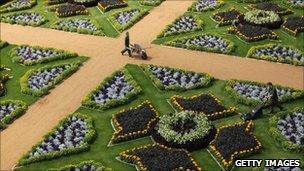Wrest Park reopens after £1.14m restoration
- Published

The restoration of the park will take around 20 years
It must surely be one of England's most ambitious gardening projects.
More than £1m is being lavished on the plan - which will see one of the country's great "lost" parks being brought back to life.
For almost half a century, Wrest Park in Bedfordshire lay unloved and merely a shadow of its former glory.
Laid out by legendary figures such as Lancelot "Capability" Brown, the grounds had become almost forgotten.
But on Thursday the public will be given the chance to visit the first phase of the restored gardens - brought back to life with sumptuous lawns and flower beds.
Head gardener Chris Slatcher said: "It's the re-awakening of Wrest Park.
"The park has been asleep, we're trying to show the public how the landscape would have looked hundreds of years ago."
Designed nearly 300 years ago, Wrest Park had been closed off and overgrown.
The gardens, near Silsoe, were created by Henry, Duke of Kent, in 1706. Changes were then made under the direction of Jemima, Marchioness Grey, in the latter half of the 18th Century.
The marchioness dedicated much of the next 60 years to the park and gardens, engaging Capability Brown.
The gardens continued to be looked after until World War I when owner Auberon Herbert, a captain in the Royal Flying Corps, was killed in action.
The estate was then sold and used as a military hospital until 1916 when the house was damaged by fire.
The gardens declined from this time and by the latter half of the 20th Century, Wrest Park housed an agricultural research institute and by the 1990s, only four gardeners maintained the grounds. This compares with a garden staff of around 50 in its heyday.
English Heritage took over the estate in 2006 and then announced a 20-year plan to restore Wrest Park as one of the pre-eminent gardens in England.
'Unique place'
In 2010 the Wrest Park revival project was awarded a grant of £1.14m from the Heritage Lottery Fund.
The first phase includes the restored Italian and rose gardens, a new exhibition on the history of the estate and access to the miles of pathways over the 90-acres.
Simon Thurley, English Heritage's chief executive, said: "Wrest Park tells the story of England's love affair with landscape.
"It is a unique place capturing 300-years of gardening history. So now with the successful completion of this first phase of restoration, Wrest Park can rightfully reclaim its place as one of the great gardens of England."
- Published2 August 2011